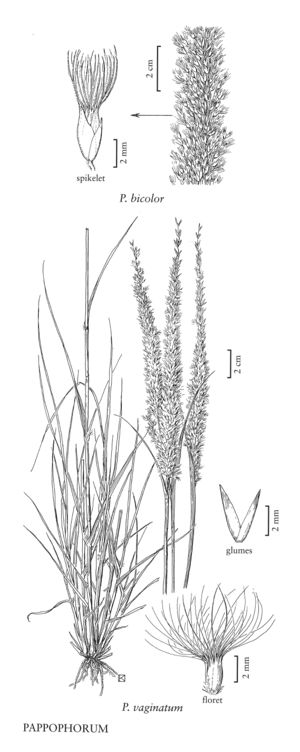Difference between revisions of "Pappophorum vaginatum"
FNA>Volume Importer |
imported>Volume Importer |
||
| (4 intermediate revisions by 2 users not shown) | |||
| Line 7: | Line 7: | ||
|synonyms={{Treatment/ID/Synonym | |synonyms={{Treatment/ID/Synonym | ||
|name=Pappophorum mucronulatum | |name=Pappophorum mucronulatum | ||
| − | |authority= | + | |authority= |
| + | |rank=species | ||
}} | }} | ||
|hierarchy=Poaceae;Poaceae subfam. Chloridoideae;Poaceae tribe Pappophoreae;Pappophorum;Pappophorum vaginatum | |hierarchy=Poaceae;Poaceae subfam. Chloridoideae;Poaceae tribe Pappophoreae;Pappophorum;Pappophorum vaginatum | ||
| Line 20: | Line 21: | ||
-->{{Treatment/Body | -->{{Treatment/Body | ||
|distribution=Maine;N.Y.;Ariz.;N.Mex.;Tex. | |distribution=Maine;N.Y.;Ariz.;N.Mex.;Tex. | ||
| − | |discussion=<p>Pappophorum vaginatum grows in similar habitats to P. bicolor, the two species sometimes growing together. Its range extends from southern Arizona to Texas and northern Mexico and from Uruguay to Argentina.</p> | + | |discussion=<p><i>Pappophorum vaginatum</i> grows in similar habitats to <i>P. bicolor</i>, the two species sometimes growing together. Its range extends from southern Arizona to Texas and northern Mexico and from Uruguay to Argentina.</p> |
|tables= | |tables= | ||
|references= | |references= | ||
| Line 29: | Line 30: | ||
-->{{#Taxon: | -->{{#Taxon: | ||
name=Pappophorum vaginatum | name=Pappophorum vaginatum | ||
| − | |||
|authority=Buckley | |authority=Buckley | ||
|rank=species | |rank=species | ||
| Line 36: | Line 36: | ||
|basionyms= | |basionyms= | ||
|family=Poaceae | |family=Poaceae | ||
| − | |illustrator=Linda A. Vorobik | + | |illustrator=Linda A. Vorobik;Karen Klitz |
| + | |illustration copyright=Utah State University | ||
|distribution=Maine;N.Y.;Ariz.;N.Mex.;Tex. | |distribution=Maine;N.Y.;Ariz.;N.Mex.;Tex. | ||
|reference=None | |reference=None | ||
| Line 42: | Line 43: | ||
|publication year= | |publication year= | ||
|special status= | |special status= | ||
| − | |source xml=https:// | + | |source xml=https://bitbucket.org/aafc-mbb/fna-data-curation/src/200273ad09963decb8fc72550212de541d86569d/coarse_grained_fna_xml/V25/V25_934.xml |
|subfamily=Poaceae subfam. Chloridoideae | |subfamily=Poaceae subfam. Chloridoideae | ||
|tribe=Poaceae tribe Pappophoreae | |tribe=Poaceae tribe Pappophoreae | ||
Latest revision as of 18:59, 11 May 2021
Culms (40)50-100 cm. Sheaths mostly glabrous, with a tuft of hairs at the throat; blades 10-25 cm long, 2-5 mm wide, flat to involute, adaxial surfaces scabridulous. Panicles 10-25 cm, tightly contracted, usually white or tawny, rarely slightly purple-tinged. Spikelets with 1(2) bisexual florets and 2 reduced florets. Glumes (3)4-4.5 mm, glabrous, acute; lowest lemma bodies 3-3.2 mm, midveins and margins pubescent from the base to about midlength, awns about twice as long as the lemma bodies, tending to spread at right angles when mature; paleas longer than the lemma bodies. 2n = 60.
Distribution
Maine, N.Y., Ariz., N.Mex., Tex.
Discussion
Pappophorum vaginatum grows in similar habitats to P. bicolor, the two species sometimes growing together. Its range extends from southern Arizona to Texas and northern Mexico and from Uruguay to Argentina.
Selected References
None.
